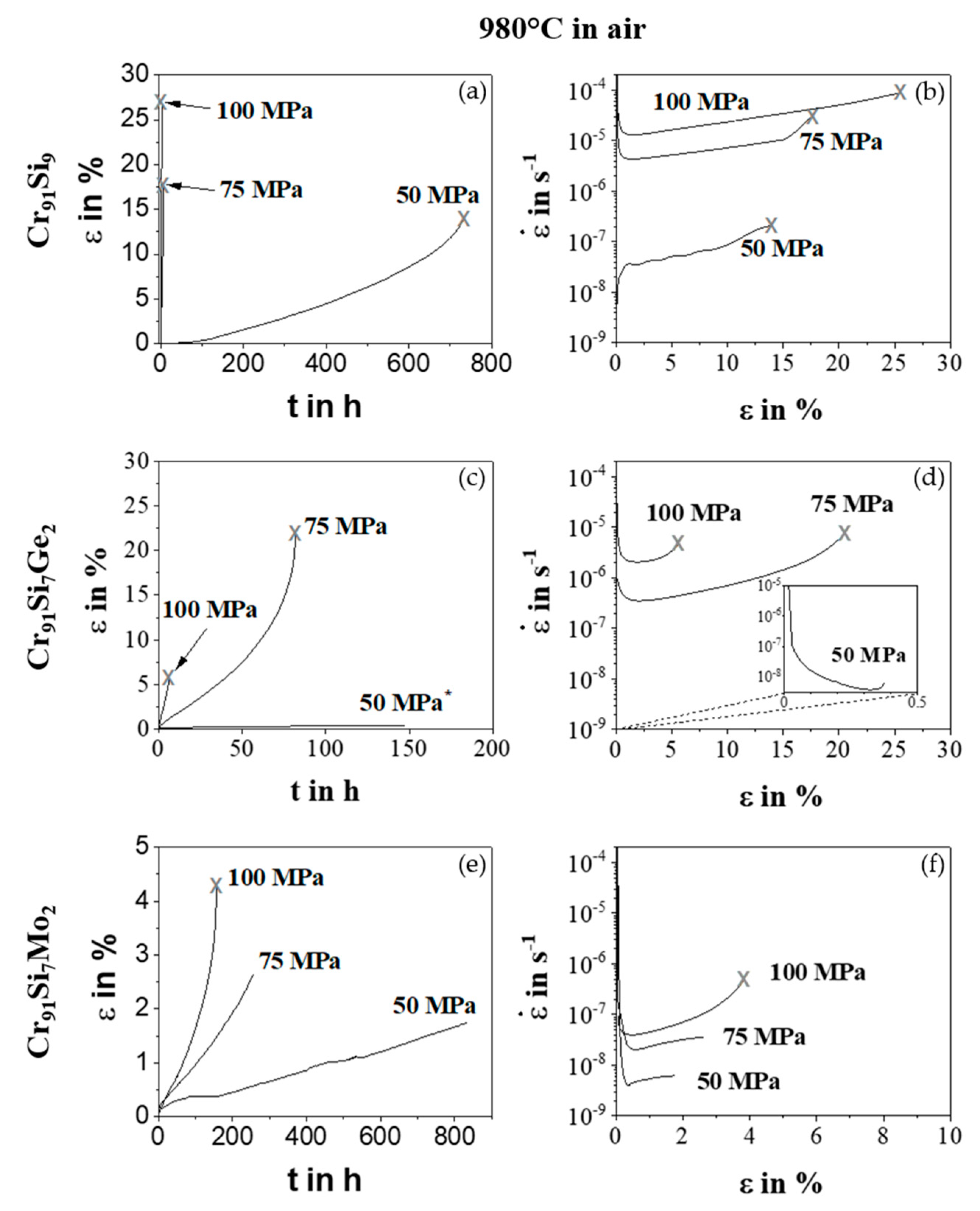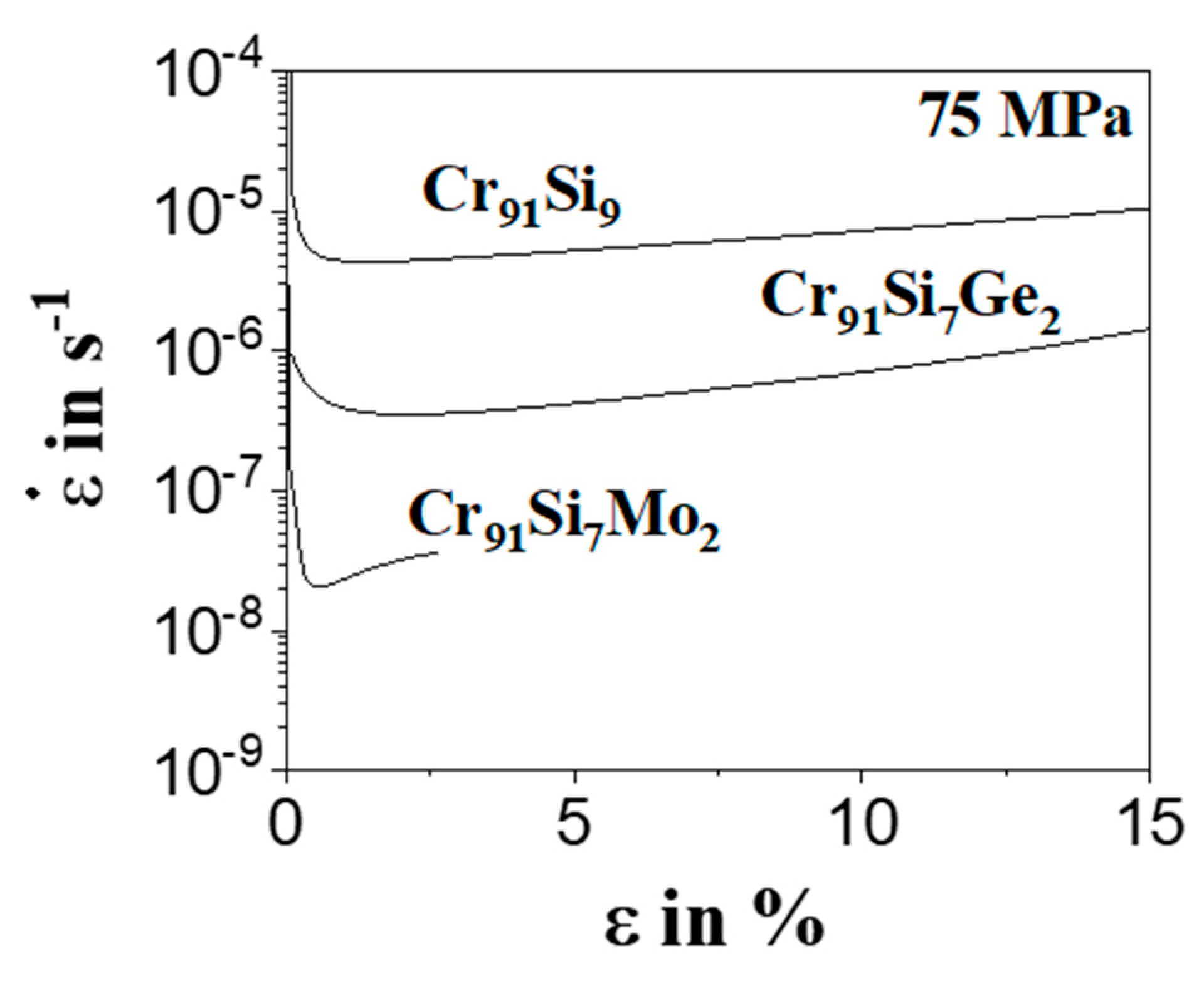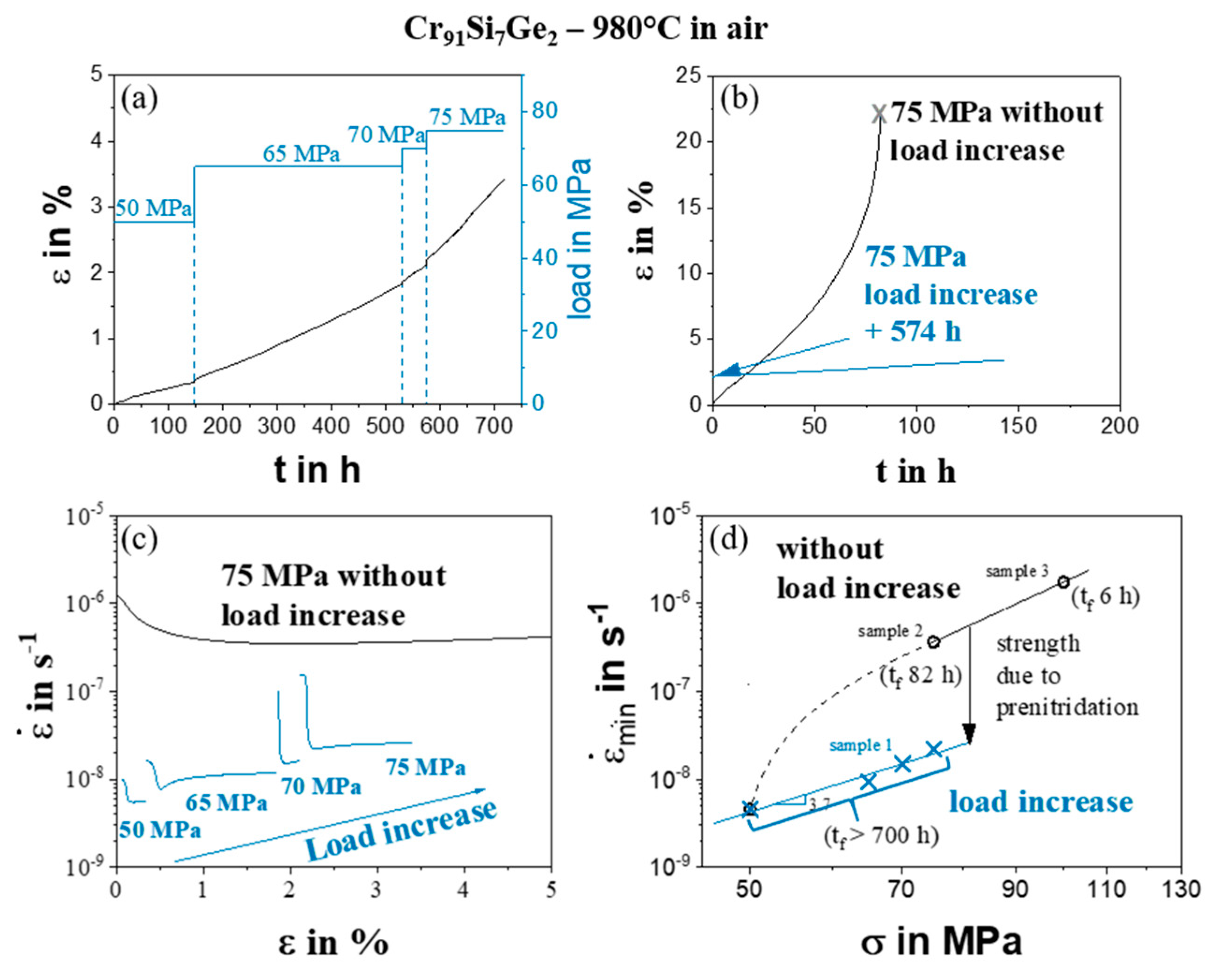Tensile Creep Properties of Cr-Si Alloys at 980 °C in Air—Influence of Ge and Mo Addition
Abstract
:1. Introduction
2. Materials and Methods
3. Results and Discussion
4. Conclusions
Author Contributions
Funding
Institutional Review Board Statement
Informed Consent Statement
Data Availability Statement
Conflicts of Interest
References
- Perepezko, J.H. The Hotter the Engine, the Better. Science 2009, 326, 1068–1069. [Google Scholar] [CrossRef]
- Bewlay, B.P.; Jackson, M.R.; Subramanian, P.R.; Zhao, J.-C. A review of very-high-temperature Nb-silicide-based composites. Metall. Mater. Trans. A 2003, 34, 2043–2052. [Google Scholar] [CrossRef]
- Dorcheh, A.S.; Galetz, M.C. Challenges in Developing Oxidation-Resistant Chromium-Based Alloys for Applications Above 900 °C. J. Oper. Manag. 2016, 68, 2793–2802. [Google Scholar] [CrossRef]
- Fleischer, R.L.; Zabala, R.J. Mechanical properties of high-temperature titanium intermetallic compounds. Metall. Trans. A 1990, 21, 1951–1957. [Google Scholar] [CrossRef]
- Landau, C.S.; Greenaway, H.T.; Edwards, A.R. Some Properties of Chromium and Chromium-Tungsten Alloys. 1. Compression Creep Tests. J. Inst. Met. 1960, 89, 97–101. [Google Scholar]
- Shah, D.M.; Anton, D.L. Evaluation of refractory intermetallics with A15 structure for high temperature structural applications. Mater. Sci. Eng. A 1992, 153, 402–409. [Google Scholar] [CrossRef]
- Ulrich, A.S.; Pfizenmaier, P.; Soleimani, A.; Glatzel, U.; Galetz, M.C. Strengthened Cr-Si-base alloys for high temperature applications. Int. J. Refract. Met. Hard Mater. 2018, 76, 72–81. [Google Scholar] [CrossRef]
- Pfizenmaier, P.; Ulrich, A.S.; Galetz, M.C.; Glatzel, U. Determination of heat treatment parameters by experiments and CALPHAD for precipitate hardening of Cr-Alloys with Si, Ge and Mo. Intermetallics 2020, 116, 106636. [Google Scholar] [CrossRef]
- Ulrich, A.S. Entwicklung von Ausscheidungshärtbaren Cr-Si-Basis-Legierungen für Hochtemperaturanwendungen: Mikrostruktur und Oxidation; Shaker Verlag: Herzogenrath, Germany, 2020. [Google Scholar]
- Gu, Y.F.; Harada, H.; Ro, Y. Chromium and chromium-based alloys: Problems and possibilities for high-temperature service. J. Oper. Manag. 2004, 56, 28–33. [Google Scholar] [CrossRef]
- Smith, W.H.; Seybolt, A.U. Ductile Chromium. J. Electrochem. Soc. 1956, 103(6), 347. [Google Scholar] [CrossRef]
- Raj, S.V.; Whittenberger, J.D.; Zeumer, B.; Sauthoff, G. Elevated temperature deformation of Cr3Si alloyed with Mo. Intermetallics 1999, 7, 743–755. [Google Scholar] [CrossRef]
- Raj, S.V. An evaluation of the properties of Cr3Si alloyed with Mo. Mater. Sci. Eng. A 1995, 201, 229–241. [Google Scholar] [CrossRef]
- Raj, S.V. A preliminary assessment of the properties of a chromium silicide alloy for aerospace applications. Mater. Sci. Eng. A 1995, 192, 583–589. [Google Scholar] [CrossRef]
- Wilms, G.R.; Rea, T.W. The tensile creep properties of some extruded chromium alloys. J. Less Common Met. 1964, 6, 184–200. [Google Scholar] [CrossRef]
- Cruse, T.A.; Newkirk, J.W. Evaluation of methods to produce tough Cr3Si based composites. Mater. Sci. Eng. A 1997, 239, 410–418. [Google Scholar] [CrossRef]
- Matsumoto, Y.; Fukumori, J.; Morinaga, M.; Furui, M.; Nambu, T.; Sakaki, T. Alloying effect of 3D transition elements on the ductility of chromium. Scr. Mater. 1996, 34, 1685–1689. [Google Scholar] [CrossRef]
- Brady, M.P.; Zhu, J.H.; Liu, C.T.; Tortorelli, P.F.; Walker, L.R.; McKamey, C.G.; Wright, J.L.; Carmichael, C.A.; Larson, D.J.; Miller, M.K.; et al. Intermetallic reinforced Cr alloys for high-temperature use. Mater. High Temp. 1999, 16, 189–193. [Google Scholar] [CrossRef]
- Carlson, O.N.; Sherwood, L.L.; Schmidt, F.A. The effect of low percentage alloying additions on the ductility of iodide chromium. J. Less Common Met. 1964, 6, 439–450. [Google Scholar] [CrossRef]
- Wilms, G.R.; Ryan, N.E. Influence of atmospheric nitrogen on the creep properties of chromium-tantalum alloys. J. Less Common Met. 1967, 12, 11–18. [Google Scholar] [CrossRef]
- Pugh, J.W. The Tensile and Stress-Rupture Properties of Chromium. Trans. Am. Soc. Met. 1958, 50, 1072–1080. [Google Scholar]
- Stephens, J.R.; Klopp, W.D. High-temperature creep of polycrystalline chromium. J. Less Common Met. 1972, 27, 87–94. [Google Scholar] [CrossRef] [Green Version]
- Ryan. The formation, stability and influence of carbide dispersions in chromium. J. Less Common Met. 1966, 11, 221–248. [Google Scholar] [CrossRef]
- Völkl, R.; Fischer, B. Mechanical testing of ultra-high temperature alloys. Exp. Mech. 2004, 44, 121–127. [Google Scholar] [CrossRef]
- Völkl, R.; Fischer, B.; Beschliesser, M.; Glatzel, U. Evaluating strength at ultra-high temperatures-Methods and results. Mater. Sci. Eng. A 2008, 483, 587–589. [Google Scholar] [CrossRef]
- Mora-García, A.G.; Mosbacher, M.; Hastreiter, J.; Völkl, R.; Glatzel, U.; Muñoz-Saldaña, J. Creep behavior of polycrystalline and single crystal Ni-based superalloys coated with Ta-containing NiCoCrAlY by high-velocity oxy-fuel spraying. Scr. Mater. 2020, 178, 522–526. [Google Scholar] [CrossRef]
- Aono, Y.; Omori, T.; Kainuma, R. Microstructure and high-temperature strength in Cr–Si binary alloys. Intermetallics 2019, 112, 106526. [Google Scholar] [CrossRef]
- Burton, B. Inverse primary creep. Philos. Mag. A 1983, 48, 299–310. [Google Scholar] [CrossRef]
- Wilms, G.R. Environmental effects on the tensile creep properties of chromium alloys. J. Less Common Met. 1968, 14, 373–377. [Google Scholar] [CrossRef]
- Ulrich, A.S.; Pfizenmaier, P.; Solimani, A.; Glatzel, U.; Galetz, M.C. Improving the oxidation resistance of Cr-Si-based alloys by ternary alloying. Corros. Sci. 2020, 165, 108376. [Google Scholar] [CrossRef]
- Solimani, A.; Schütze, M.; Stark, A.; Galetz, M.C. Nitrogen transport through thermally grown chromia scales. Corros. Sci. 2018, 145, 180–190. [Google Scholar] [CrossRef]
- Ulrich, A.S.; Glatzel, U.; Galetz, M.C. Discontinuities in Oxidation Kinetics: A New Model and its Application to Cr–Si-Base Alloys. Oxid. Met. 2021, 95, 445–465. [Google Scholar] [CrossRef]
- Fleischmann, E.; Konrad, C.; Preußner, J.; Völkl, R.; Affeldt, E.; Glatzel, U. Influence of Solid Solution Hardening on Creep Properties of Single-Crystal Nickel-Based Superalloys. Metall. Mater. Trans. A Phys. Metall. Mater. Sci. 2015, 46, 1125–1130. [Google Scholar] [CrossRef]






| Sample | Cr in at.% | Si in at.% | Ge in at.% | Mo in at.% |
|---|---|---|---|---|
| Cr91Si9 | 90.9 ± 0.4 | 9.1 ± 0.2 | - | - |
| Cr91Si7Ge2 | 90.4 ± 0.2 | 7.5 ± 0.1 | 2.1 ± 0.1 | - |
| Cr91Si7Mo2 | 90.3 ± 0.5 | 7.7 ± 0.2 | - | 2.0 ± 0.1 |
Publisher’s Note: MDPI stays neutral with regard to jurisdictional claims in published maps and institutional affiliations. |
© 2021 by the authors. Licensee MDPI, Basel, Switzerland. This article is an open access article distributed under the terms and conditions of the Creative Commons Attribution (CC BY) license (https://creativecommons.org/licenses/by/4.0/).
Share and Cite
Pfizenmaier, P.; Ulrich, A.S.; Galetz, M.C.; Glatzel, U. Tensile Creep Properties of Cr-Si Alloys at 980 °C in Air—Influence of Ge and Mo Addition. Metals 2021, 11, 1072. https://doi.org/10.3390/met11071072
Pfizenmaier P, Ulrich AS, Galetz MC, Glatzel U. Tensile Creep Properties of Cr-Si Alloys at 980 °C in Air—Influence of Ge and Mo Addition. Metals. 2021; 11(7):1072. https://doi.org/10.3390/met11071072
Chicago/Turabian StylePfizenmaier, Petra, Anke Silvia Ulrich, Mathias C. Galetz, and Uwe Glatzel. 2021. "Tensile Creep Properties of Cr-Si Alloys at 980 °C in Air—Influence of Ge and Mo Addition" Metals 11, no. 7: 1072. https://doi.org/10.3390/met11071072
APA StylePfizenmaier, P., Ulrich, A. S., Galetz, M. C., & Glatzel, U. (2021). Tensile Creep Properties of Cr-Si Alloys at 980 °C in Air—Influence of Ge and Mo Addition. Metals, 11(7), 1072. https://doi.org/10.3390/met11071072







